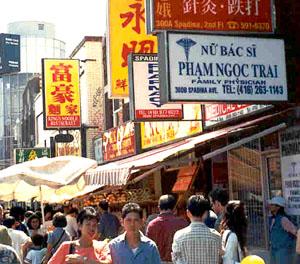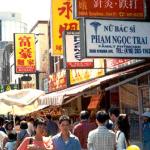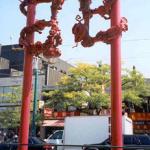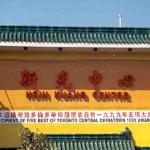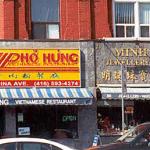Chinatown Sextet - Chinatowns in the Greater Toronto Area - 1
(First of Three Parts)
Canada's first Chinatowns, in the British Columbia cities of Victoria and Vancouver, were formed by the thousands of immigrants from villages in Kwantung Province who came to work as labourers on the Canadian Pacific Railway. Their willingness to work long hours for much less pay created a growing animosity; rampant unemployment and the perception that the Chinese were taking the local jobs brought resentment and discrimination. The two west coast settlements grew out of that prejudice and enmity; they were as much bastions as communities.
When the railway was completed, many Chinese headed east, to cities like Toronto, ironically escaping racism on the railway built to unite a nation.
By 1900, there were two hundred Chinese residents in Toronto, and most worked in laundries. Chinese Canadians now comprise the largest ethnic group in what the United Nations has designated the world's most multicultural city. After English, Chinese is the most spoken language in the homes of The Greater Toronto Area. The small pocket of hand laundries at the turn of the century has evolved into six distinct Chinatowns with a combined population of half a million And they no longer do laundry.
* * * * *
1. Downtown Chinatown
Toronto's original Chinatown was located in the area now occupied by the twelve-acre complex of the "new" city hall. During its construction in the early 1960s, the Chinese community, by then the third largest in Canada, moved to its present site at the crossroads of Spadina Avenue and Dundas Street.
Downtown Chinatown has all the vitality and hustle bustle street energy that is characteristic of similar neighbourhoods around the world. The wide promenades of Spadina become extensions of stores and narrow to single file in front of makeshift stands displaying fruits and vegetables, labelled with Chinese characters drawn on pieces of cardboard. Lychees and rambutans hang in bunches from canvas awnings; a sliced durian is displayed, the foul odour hanging like a fetid cloud. It seems like every other store has barbequed ducks and whole pigs hanging in the window. Wing Fong, Hong Fok, Ting Hing, Po Chi Tong, Chung Mee -- trading companies, herbalists, and restaurants have names that form a tone poem.
Neon signs flash the message "Herbalist and Acupuncturist on Duty". There is a clamour as a press of jostling customers throng around a hole in the wall shop, which is selling assorted vegetables on a foot long bun for a dollar each. A monk in a grey robe stands in the middle of the people-thick sidewalk, an alms bowl on a box in front of him; the crowd flows around him like water around a rock. His hands gesture towards the bowl with choreographed, ritualistic, articulated moves; a serene smile is locked on his face.
Merchandise lines the steep steps to the basement location of the Tai Kong Supermarket; inside, the narrow aisles are bustling. On the floor, a small Buddhist shrine protects against evil spirits. The miniature temple has a golden dragon motif and is strung with red lights; tiny golden cups of tea and pieces of apples and oranges have been placed as offerings. Numerous sticks of incense fill the air with wisps of sandalwood
In a doorway, two elderly women in baggy pyjama-like pants and Mao style tops sit on their haunches behind overturned cardboard boxes on which are displayed a few bunches of chives, a couple of white radishes, and several stalks of Bok Choi. One is clipping her nails, both are smoking, and neither seems interested in making a sale as they speak, simultaneously, in low tones.
Near a passenger shelter jammed with people awaiting streetcar number 510, a monk in a saffron robe, his head freshly shaved, paces while talking on a cell phone.
A sandwich board sign promoting the services of an astrologer and geomancer advertises, in both Chinese and English, his mystical talent as a "destiny reform specialist"
At the corner of Dundas and Huron is the Chinese Gospel Church, which offers services in Cantonese, Mandarin, and English. Across from the church is the Ten Ren's Tea Shop which has a large display of hand crafted teapots as well as a vast selection of teas, including one called "monkey pick" since it is harvested from steep cliffs by specially trained monkeys In front of a traditional medicine shop, barrels are mounded with different varieties of ginseng, dried mushrooms, ground seashells, pieces of antler, and dried seahorses. There are boxes of what appears to be animal tongues priced at $30 a pound.
Noticing our curiosity at the various items, the owner, in spite of his limited English, attempted to explain. Picking up a piece of ginseng, he tapped his chest with the palm of his hand; he pointed to the dried seahorses and then put his hand on his stomach. When we asked about the tongues, he seemed reluctant. We soon realized that his hesitancy was in deference to the presence of a lady, for when Doris turned and walked a few steps away, he whispered "Viagra", apparently one of the few English words he knew, and then, with a wide grin, made the universal sign with his forearm. By gesture he indicated that this elixir was consumed in the form of tea, and then with thumbs up exclaimed, "Good".
The street sounds are suddenly punctuated by exploding firecrackers and the beating of drums as four men under a dragon costume herald the opening of a restaurant and augur good fortune by driving away evil spirits.
To the north and south of the Spadina and Dundas intersection are two "gateways"; unlike the large traditional Chinese gates, which span streets, both of these are in the broad, tree-lined median used by streetcars. At each location is a pair of red columns at the top of which are figures from Chinese mythology; a phoenix, a dragon, a unicorn, and a monkey flow together and intertwine to create the two sculptures entitled "Gateway", created by Millie Chan.
Another pair of columns has been erected in the median further south on Spadina on either side of the streetcar tracks. On the top of the east side column there is a dragon, and on the west side column is a cornucopia. Created by David Hlynsky and Shirley Yanover, the monuments not only symbolize the union of eastern and western cultures, but also perhaps reflect the Asian concept of the west as a land of plenty and opportunity.
Although the majority of enterprises in the area are located in traditional shophouses, there are two mall concept establishments of note. Chinatown Centre, on the west side of Spadina, south of Dundas, has numerous glassed in stores built around an open middle. Street level and second floor stores sell such diverse items as shoes, clothes, electronics, Asian CDs and videos, jewellery, and cameras, as well as popular tourist chinoiserie as silk slippers, fans, kimonos, emerald coloured Buddhas, back scratchers, and replica thousand dollar bill key chains. In the basement level is a food court with outlets such as "Dragonball Deli." Each eatery prominently displays a green "Pass" certificate issued by the Health Department, which inspects all Toronto restaurants.
We were at one of many luggage stores in the centre and quickly learned that haggling over prices is not only acceptable, but also expected. A two-piece set of hand luggage on wheels with matching shoulder bag was discounted by twenty percent and then an additional ten percent with very little prompting. As is the custom in most stores in the area, both the sales tax and the goods and service tax, which normally add fifteen percent to the bill, were waived.
"Competition is cut throat," the vendor explained with an exaggerated wince, and then repeated for emphasis, "Cut throat. If I didn't also do tailoring, I would be bankrupt. Finished."
In our conversation with him we mentioned that we were going up to the third level for dim sum at a restaurant that we had been to a couple of years ago. He shook his head. "It closed over a year ago. Too much competition. It's cut throat."
Dragon City, on the southwest corner of Spadina and Dundas, is a smaller version of Chinatown Centre. Establishments like Dai Kuang Wah Herbs, Ginseng and Antler Market stand near a Giorgio Armani boutique. At Yummy Refills, bubble teas are available in numerous flavours, and signs advertise quick snacks like "Counterfeit Shark's Fin Soup", "Pork Intestine", and "Pig Skin with Radish".
There is no difficulty in finding a place to eat in this neighbourhood; restaurants abound. One of the most popular, Bright Pearl Seafood Restaurant, is located in the distinctive yellow walled, green tile roofed Hsin Kuan Centre at 346-348 Spadina. Guarded by two lions, the entrance to the second floor banquet hall is around the corner on St. Andrew Street. Scores of varieties of dim sum on carts stacked almost to the tottering point with bamboo steamers and are wheeled by ladies who sing out their wares in Cantonese, their voices barely audible over the echoing din. In the evening the room is much quieter and less hectic as dim sum gives way to Cantonese cuisine on a menu featuring over a hundred and fifty choices.
Other restaurants along Spadina that are always busy, a reliable indicator of quality and reasonable prices, include Lee Garden at number 331 which lists the day's specials on a chalk board, Swatow at number 309 which specializes in Chiu Chow cuisine, and Lucky Dragon at number 418 which features both Hunan and Szechuan cooking. Peking style cooking, including a large selection of vegetarian dishes can be found at the popular Champion House at 480 Dundas where the house specialty is Peking duck
Downtown Chinatown is in the midst of a transformation that has been in progress over the last few years; there is an ever-growing Vietnamese presence. Although most of the older Chinese are remaining in the area, the younger generations have chosen to relocate to the northern suburbs.
Restaurants especially reflect the Vietnamese influence. Pho eateries are everywhere, and it is easy to discover those with the best food since they are always crowded. One of the busiest is Pho Hung at 350 Spadina; it is easily found because of an unusual landmark in front-a cat stands on a large chair, which sits atop a red column.
We visited at two o'clock on a Tuesday afternoon and there was a line up. Sitting at one of the twenty or so tables was akin to eating on an airplane, in economy class. The cramped seating required that elbows be pressed tight to the sides, making chopstick use even more challenging. The flavourful rich pho made up for the confined conditions. Steaming large bowls about the size of a tureen were overflowing with thinly sliced beef on top of rice noodles, bean sprouts, chopped shallots, and coriander; side dishes provided additional crispy bean sprouts, sprigs of Vietnamese mint, lime wedges, fish sauce, garlic sauce and tiny green chili peppers which should be avoided unless you enjoy eating fire. Like most pho houses in the area, Pho Hung forgoes décor to concentrate on the food. In the summer, there is a covered patio along St Andrews that doubles the seating capacity.
Two other Vietnamese restaurants that are always busy are Sai Gon Palace at 454 Spadina where the Special Beef Pho, number one on a menu of 173 items, is exceptional, and Bun Saigon at 252 Spadina. As the name suggests, the latter specializes in "Bun", a vermicelli soup with radishes, carrots, basil leaves, and bean sprouts with a choice of beef or chicken.
* * * * *
2. Chinatown East
As the population of the Spadina and Dundas neighbourhood grew, and property became expensive, a second Chinese community formed around the intersection of Broadview Avenue and Gerrard Street, in Toronto's east end.
Like its downtown counterpart, the road signs are in both Chinese and English, and like downtown, it is a lively shophouse neighbourhood with living quarters above stores with street displays that burst out onto the sidewalks. Salted black duck eggs are piled beside chicken eggs that have been boiled in a mixture of medicinal herbs. Red Dragon Fruit, their white meaty flesh flecked with thousands of black seeds are individually wrapped and stacked in a mound.
At a makeshift display on numerous inverted boxes, a girl of about ten folded and organized T-shirts into stacks according to size and colour. Finding the correct size was easy, but the desired colour was not.
"This is nice," the young vendor suggested, spreading the shirt wide in front of her. "Eight dollar," she shouted from behind the shirt. As she reappeared, she saw my shaking head, and frowning, she folded it up and put it into a plastic bag. "OK. Five dollar. Take."
We entered a traditional apothecary and were greeted with glances of suspicion, making us feel like trespassers. Our uneasiness quickly passed as the herbalist's initial misgivings gave way to an appreciation of our interest and a patient willingness to answer questions.
An elderly woman sat on a chair at the rear of the narrow store and was conferring with the doctor. We took turns discretely observing the consultation. Her tongue was thoroughly perused, her pulse was taken, her eyes were scrutinized; the patient and doctor conversed in low tones. A prescription was written and she took it to the counter to be filled, eyeing us with apprehension.
The herbalist spread three squares of paper on the glass counter top and then, using a hand held balance scale, carefully weighed out dried herbs, pieces of bark, slices of antler, portions of twigs, and additional unfamiliar items. Shell fragments were ground by mortar and pestle and added to the growing mounds on each paper square.
Floating in a large jar in the enclosed glass below the counter, a ginseng root floated in a brown tinged liquid, thin tendrils meandering in suspension; its price, we learned later, was $1200. Behind the counter were numerous drawers hiding arcane and mysterious ingredients. Lining the shelves were large jars containing dried items labelled with Chinese characters, which the herbalist, with much forbearance, and much straining for words, agreed to translate. "Abalone...shark fin...ah, fish maw...I don't know how you say this one in English...sea cucumber...ah, geoduck...brown fungus...I don't know how you say this one...."
Still regarding us with what appeared to be distrust, the patient left after paying thirty dollars for the consultation and fifteen dollars for her three doses of prescribed remedy.
We learned that the ingredients would be boiled for forty minutes, strained, and consumed as tea. Although he didn't disclose her malady, the herbalist had no reluctance in predicting the efficacy of the medicine. "It will work," he said matter of factly. "The doctor is very skilled."
When we inquired how the tea would taste, we were surprised by his offer to sample a tonic that he had steeping in the back room. Two small steaming cups of a foul smelling concoction were produced, and we soon regretted our curiosity. As the herbalist watched, peering over his reading glasses, his bushy eyebrows arched, we sipped the tea. It was vile. "Medicine is supposed to taste bad," he stated without smiling. "For good taste, eat dim sum."
Finding dim sum in this area, however, is now difficult. The Vietnamese presence seen in Downtown Chinatown has occurred in this neighbourhood to such a degree that the sobriquet "Little Saigon" is now used.
Pho restaurants are plentiful. Again using the busy factor as an indicator of quality, Pho Hung Long at the corner of Broadview and Gerrard and Pho Xe Lua at 625 Gerrard are the most popular eateries. Pho Xe Lua, which also has a location on Spadina, has a menu with over seven hundred items. Our lunch of two huge bowls of beef pho, and shared orders of deep fried calamari, and both fried and cold spring rolls, with tea came to $16.
While the older Chinese are content to remain in both Chinatown East and Downtown Chinatown, a desire for newer, larger homes on more spacious lots, along with the wish to integrate, have prompted the younger generations to join the waves of new immigrants from Hong Kong who have avoided the city's ethnic pockets in favour of settling in the suburbs, towns, and cities that fringe Toronto's metropolitan area. To meet the changing demographics, the construction of Chinese theme plazas and malls quickly followed. With modern malls replacing traditional shophouse neighbourhoods, the satellite Chinatowns came into existence.
* * * * *
(End Part One, continued in "Chinatown Sextet", Part Two.)
* * * * *
 ThingsAsian
ThingsAsian